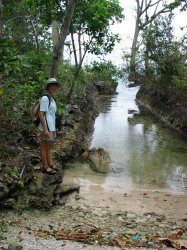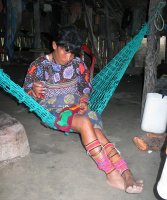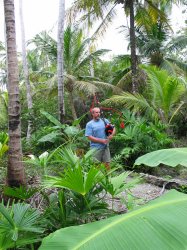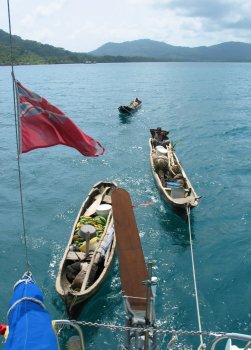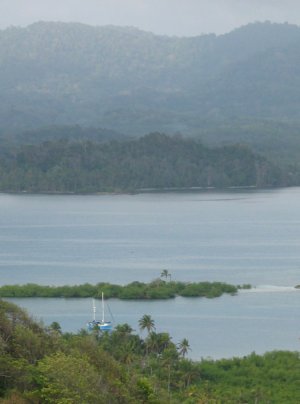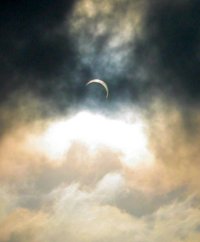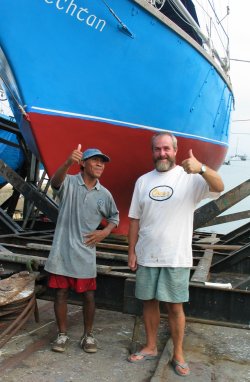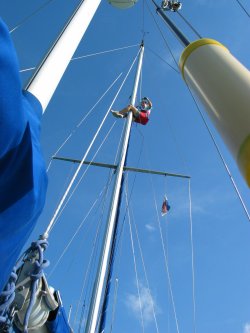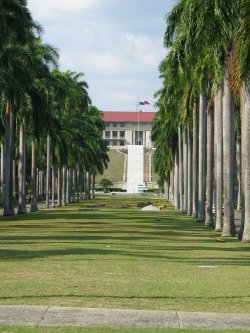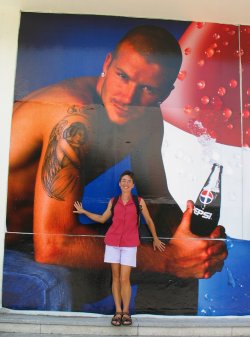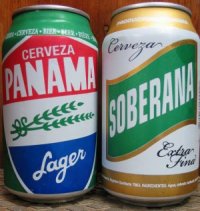 Panama
- March/April 2005
Panama
- March/April 2005
|
Twenty years ago, Tom read John Prebble's book, The Darien Disaster. It was an account of an attempt by Scotland to set up a trading colony around the year 1700 in what is now Panama. The colony was, as the book title suggests, not very successful. The venture wasted an enormous amount of money (mostly subscribed by Scots) and about 2000 lives were lost to disease and fighting with the Spanish before the whole idea was abandoned. What fascinated Tom was the fact that, in spite of the historical significance of the failure, very little mention is ever made of of it in Scotland. Far more Scots know about the massacre of Glencoe, in which around 50 were killed, than know about the Darien venture. The reason seems to be that as a nation, we are reluctant to face up to why the venture failed - the colony was poorly led, poorly planned and to be honest it wasn't such a great idea as everyone believed. However, at the time, it united Scotland in a dream of empire and there was no shortage of volunteers to be a settler in the new colony of Caledonia. And there's the lasting tragedy - despite the suffering and sacrifice of these eager volunteers, they are at best forgotten. In fact, at the time, the few "'lucky" survivors who made it home were villified for their failure.
Punta Escoses, looking more like Scotland than Panama . On 1st March 2005, 305 years to the day after the start of the final Spanish attack on the colony, we rounded Punta Escoses (Scots Point in Spanish) and dropped anchor in the bay, just off what was Fort St Andrew and the town of New Edinburgh. It can have changed little since the Scots were here. The Kuna indians are still the only inhabitants of the area. The Scots settlers described their dugout canoes, their small stature, the women with their gold nose rings and beads, their thatched huts and their friendly welcome.... and it's still true today. The village of Sukunya now stands where the huts of New Edinburgh once stood. |
|
The moat is all that survives of Fort St Andrew, a wooden stockade built to defend the new colony. |
The end of the moat reached the sea through this channel, hacked from the coral stone. |
|
We made friends with the Martinez family at Sukunya: Ricardo, Miguelina and their youngest children - two daughters Ludistira and Almaisobana and son Rignelio. We visted their house and drank Maddoon (a kind of banana drink) and they came to the boat and drank coffee and taught us some of their language. The Kuna generally do not allow photographs of themselves to be taken, so we were very lucky to have met the Martinez family! |
The Martinez family. |
|
The family house in Sukunya. |
Ricardo and a baby wild pig. They also kept a couple of tortoises, all destined for the pot eventually! |
|
While Kuna men dress in western clothes, the Kuna women wear traditional dress of a head scarf, wrap-around printed skirt and a blouse with intricate hand-sewn reverse applique panels on the back and front. These are called molas and are now sold as art worldwide. In the tourist shops you can also see them made into such items as shopping bags, cushions, pot holders and wall hangings. Whenever the Kuna see merkis (pale-skinned foreigners), they also see a mola-selling opportunity and paddle out to show you their work. Miguelina's molas were very fine and we bought a couple. She also gave us three as presents, stitching one onto a t–shirt for Tom. The Kuna ladies also wear tight beading up their calves and forearms - well-formed muscles on these parts of the body are considered unattractive, so the beading not only helps to constrict these muscles, but the bright colours also distract the eye from the skin underneath. Gold nose clips and finger rings are popular, as is a dollop of bright red rouge on each cheek. The Kuna loved looking at magazines and by sharing an old copy of "Hello" we were surprised, and rather delighted too, to meet people who had never heard of the Queen, Prince Charles, Princess Diana, David Beckham, or even the recently re-elected George W. Bush! |
|
Miguelina stiching a mola. |
The finished mola on a t–shirt. |
|
|
Our first mola. |
|
|
Piping inside what was Fort St Andrew.
|
|
Before we left, Tom played his pipes to settle any restless ghosts - Scotland the Brave and a couple of slow airs. It doesn't take much to imagine how the settlers felt, dying in their hundreds of dysentry or malaria, or while battling against the marauding Spanish while so far from home and all for nothing. |
|
The Kuna use dugout canoes or "ulus" to go everywhere and manouevre them expertly with big hand-carved paddles. It takes about 2 weeks to hew out a big ulu with an adze and about a week for a smaller one. After a few days at Puerto Escoses we decided to head north and said our goodbyes to everyone. |
The Martinez family in their "ulu" or dugout canoe. |
|
Leaving Punta Escoses.
|
|
We gave a tow to three ulus who were heading from Sukunya to the main village of Mulatupu, twelve miles up the coast. On the way we ran into a problem... we were stopped by a fast police launch that was on patrol from the main border post at Obaldia, twenty miles south. We were planning on clearing into Panama further north at Porvenir, but they had other ideas! So we headed south again, passing Punta Escoses on the way and two days later passing it again on the way back, complete with loads of permits, stamps and paperwork and $120 out of pocket.
|
|
On the way to Obaldia and again on the way back, we anchored in the bay of Carreto. It was from here that Vasco Nuñez de Balboa, the Spanish Conquistador, crossed over and became the first European to see the Pacific Ocean in 1513.
|
Ulus on the beach at Carreto. |
|
Nechtan anchored near the village of Caledonia, just north of Punta Escoses. |
We stopped for a couple of nights in a beautiful sheltered bay near the Kuna village of Caledonia (wonder where that name came from!) just north of Punta Escoses, then headed north to the main group of the San Blas islands.
Rosa and Celina from Caledonia. |
|
Here come the coconut sellers.
|
|
The next few days were spent, sailing between beautiful tropical islands - the kind we dreamt about before leaving: palm trees blowing in the breeze and no sound except the waves breaking on the protective reef. An environmental thought: You can easily see how a rise in sea level of just 1 metre, or a tsunami, would have such a devastating effect on these islands.
|
|
|
Even the grey skies could be bonny! |
|
|
Not a good day for this poor chap - he has been in a fight and lost 3 legs - and he was only 2 inches across to start with! |
|
Even some fellas sew molas - Venancio and Idelfonso at Green Island. |
|
Typical San Blas scene of tropical island and sailing canoe. Many cruisers spend months in the San Blas, drawn by the perfect anchorages, calm seas and tranquility. But, we couldn't hang around as we were heading for the Panama Canal. The constant stream of shipping tells you that you are nearing the Panama Canal. |
|
On the coastal sail down to the canal, we witnessed a high-powered motorboat being chased by a plane up the coast. The motorboat stopped less than half a mile from us and we heard a brief exchange of machine gun fire between it and the spotter plane circling overhead. The motorboat took off again and was eventually abandonned further up the coast. We heard later that it was drug runners being chased by the customs police. Thank goodness they didn't feel like taking any foreign hostages that day! We arrived at the Caribbean side of the canal on 14 March and anchored amongst about 30 other yachts who were also waiting to transit. With a waiting time of 15 days, we had the opportunity to whittle down the never-ending list of maintenance jobs. At least we were not distracted by the sights of Colon, which is a dangerous, dirty, smelly place. As it turned out we went through the canal 3 times - once on Dreambird just for the practice, once on Nechtan and finally on Folly, linehandling for them as they had linehandled for us. Every yacht going through is required to have a helmsman and 4 linehandlers, one for each of the long mooring lines used to hold the boat's position in the locks.
|
|
Nechtan's transit started on the evening of 30 March, in pouring rain, after a wait of 15 days. The pilot was put onboard just before dark and we headed off to the Gatun Locks, 3 locks which raise the boat to the level of Gatun Lake. The canal is a great piece of engineering, built by the Americans and opened in 1914. It was run by the Americans until 1999 when it was handed over to Panamanian control. Many of the original features are still in use, including the massive rivetted iron lock gates. And did you know that the Panama Canal (at West 079°) is further east than Miami (at West 081°)!
|
Pilot arriving in the rain. |
|
Motoring down the Culebra Cut with Kerry and John from Folly, Sue, Erik (a linehandler) and Cooper the pilot. |
|
That night we moored to a buoy in Gatun Lake and early next morning, headed off on the thirty miles to the Pedro Miguel Locks, the first "step down" to the Pacific side.
|
|
Just before Pedro Miguel we negotiated the infamous Culebra Cut, one of the most difficult and labour-intensive parts of the canal construction. Six thousand men took seven years to dig the channel through shale and rock. |
|
Pedro Miguel Lock, full of water... |
...and after they let the water out. |
|
Next were the two locks at Miraflores and finally we popped out the other side into the Pacific Ocean! By mid-afternoon on 31 March we were passing under the Bridge of the Americas, which marks the end of the canal and the "official" start of the Pacific Ocean. This bridge is currently the only road link between north and south America, although the new Centennial Bridge is due to open later this year.
|
Passing under the Bridge of the Americas. |
|
Who turned out the lights? |
|
While in Balboa, preparing and provisioning for the Pacific crossing, we saw a near-total solar eclipse, on 8 April. We were also hauled out on the marine railway. The Sigma antifouling paint that we had applied in Venezuela last November barely lasted 3 months! So we had to remove it completely and repaint with Jotun, which hopefully will perform better - after all, there's not much chance to haul out and repaint between here and Australia!
|
|
The antifouling team - Antonio and Tom. |
|
Of course Sue just hung around with the weight off her feet while the boys played at painting! |
|
In between jobs, we managed to get out and about in Balboa, but sadly never managed to see all the sights or people that we wanted.....next time! |
|
The bus drivers of Panama are very proud of their mobile works of art. |
|
Can you tell that the Americans were here? |
|
The fountain in the centre of Balboa commemorates a former president of Panama. The water was only turned on for a few hours every morning! |
|
Amazing who you can meet in Balboa! (For you non-footballers, it's David Beckham!) |
|
Just some of the paperwork generated during our stay in Panama. (The worst country so far for bureaucracy.) |
|
Tom never could find the Drunkerana! (Soberana is a light beer.) |
|
Found in the supermarkets of Panama: Scottish shortbread? - actually they're made in Denmark!! A bit cheeky, but at least they must think Scottish stuff is worth copying! |
|
A view out over Balboa Yacht Club pier. |
|
On 24 April, as ready as we could be, we set off for the Galápagos, about a thousand miles southwest. |
